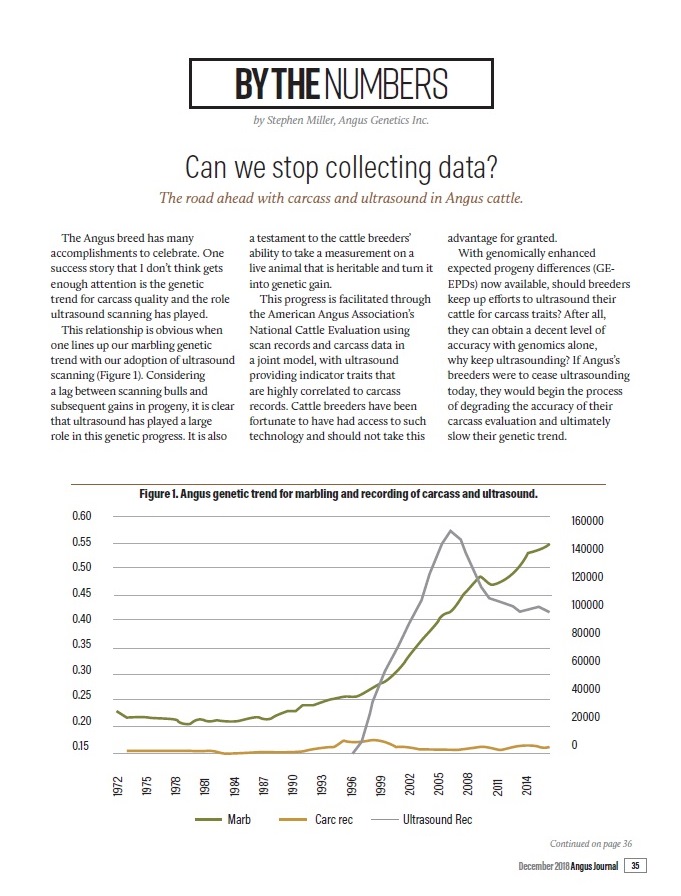Ultrasound and DNA: Increasing Accuracy in EPDs
Ultrasound technicians will hear the question, “Do I need to ultrasound? I use DNA.” The short answer is yes, ultrasound data is important. The reality is that the explanation of the“yes” can be complex and lengthy. Many industry leading scientists and breed associations have written numerous articles and reports on the use of DNA in genetic evaluation. Consider checking out the following links to become better informed.
1.The following visual, two-page document from the Australian Beef Cooperative Research Centre provides a nice introduction/refresher to DNA.
“There are approximately 3 billion base pairs in bovine DNA. The sequence of these base pairs contains the‘message’ in DNA. Sequence differences form the basis for differences between animals in their genetic merit.”
http://www.beefcrc.com/documents/publications/fact-sheets/FS12-UnderstandingDNATechnology.pdf
2. In 2008, Matt Spangler, Ph.D. gave a report to the Ultrasound Guidelines Council (UGC) field technicians’ symposium. This five-page article is a must read for ultrasound technicians. The beef industry and genetic evaluation has changed over the years, but the paper is still relevant.
“If you scan or interpret images from one breed, it has an influence on every breeder within that breed and every commercial ranch that purchases seedstock within that breed. To that end, it is paramount that all involved with this industry work in concert to continually make improvements, validate technology, and continually educate themselves.”
http://charolaisusa.com/pdf/2009/oct21/UltrasoundandGeneticEvaluation.pdf
3. The American Angus Association’s AGI has a two-page document explaining genomically enhanced EPDs. This paper explains that genomic testing is NOT a replacement for phenotypic testing.
“Genomic testing is one more tool for breeders to use to more accurately predict the future performance of animals as parents in the population, but this is not a replacement to performance data recording.”
“Phenotypic measures continue to be an important part in further development of improved genomic panels and the refinement of this technology over time.”
https://www.angus.org/AGI/GenomicEnhancedEPDs.pdf
4. This 16-page report cites many research reports and provides a straightforward, yet more in depth explanation of DNA and its usefulness to the beef industry.
“DNA marker tests results should not be used to replace traditional selection based on EPDs and economic index values, but rather should be seen as providing an additional source of information from which to predict genetic merit.”
https://beefrepro.unl.edu/proceedings/2011northwest/12_nw_epddna_vaneenennaam.pdf
5 . More recently, Dr. Matt Spangler, University of Nebraska wrote a couple of articles to update breeders on the use of genetic information in EPDs. Notice that the way DNA information is incorporated in today’s EPDs is different than 5-10 years ago.
“And yet another reminder, even in the era of genomic selection, phenotypes(observed performance records) are still king and producers must not stop or limit phenotypic data collection.”
https://articles.extension.org/pages/74697/recent-changes-to-national-cattle-evaluation
6. The use of DNA does not erase the need of collecting phenotypic data. While the following article does not specifically target ultrasound data, ultrasound data is one type of phenotypic information. Read this article to learn more.
“There is still a need to collect and routinely record phenotypic information by seedstock producers. Commercial producers need to realize that EPDs, and economic index values, are the currency of the realm for beef cattle selection. Genomic technology only makes these tools stronger, it does not replace them.”
7. This document warns of the effects of stopping the collection of phenotypic data. As much as DNA has shown us, it is not a save all or a reason to abandon performance testing.
“Genomic predictors should be viewed as an additional source of information for EPD calculations, not the complete picture.”
https://articles.extension.org/pages/72640/value-of-collecting-phenotypes
8. The National Beef Cattle Evaluation Consortium offers the following “white paper” on their website. Written by leading industry scientists, this paper goes into a little more depth explaining the use of DNA in national cattle evaluation (EPDs).
“Despite considerable progress in the arena of genomics-based selection tools over the past 20-plus years, including the mapping of the bovine genome, genomics has not developed into a standalone tool to replace EPDs.”
http://www.nbcec.org/topics/WhitePaperGenomicsTechnology.pdf

Angus Journal December 2018
